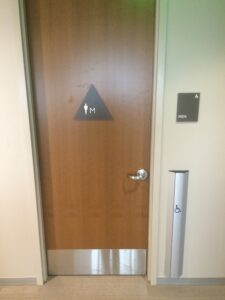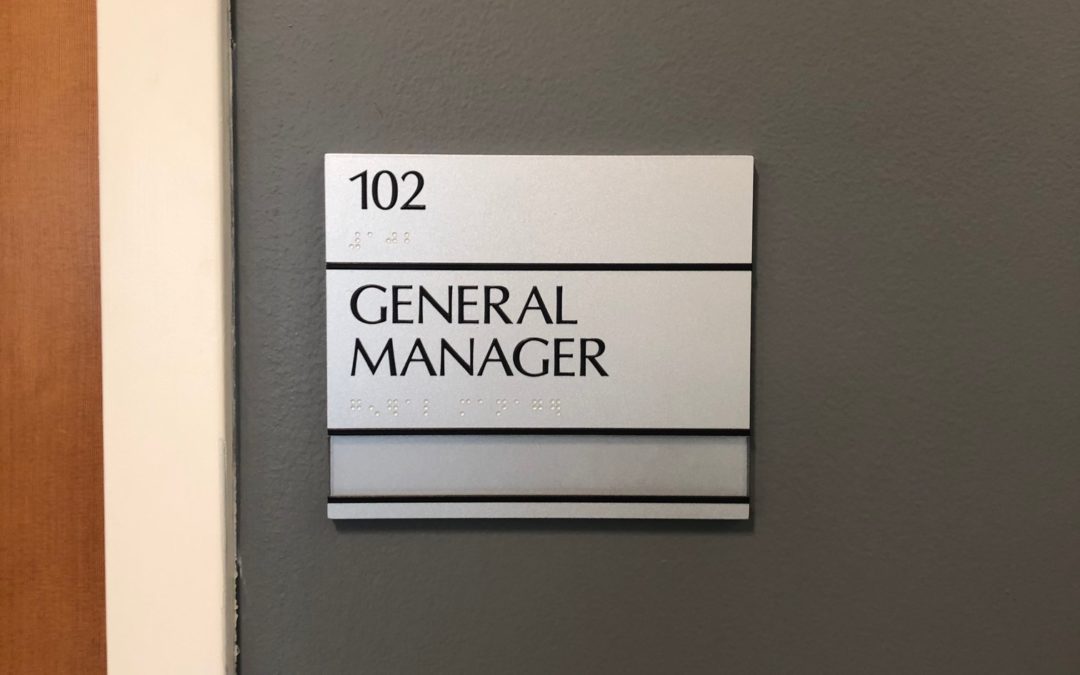At SignWorks, we’ve worked with many clients to create ADA braille and tactile signs that meet accessibility standards while fitting the unique needs of each client. From schools to government agencies, we’ve produced a wide variety of signs using different fabrication methods. In this post, we’ll explore the different approaches we use for making ADA-compliant signs, comparing and contrasting a few specific projects.
What Are ADA Braille and Tactile Signs?
ADA braille and tactile signs are designed to help people with visual impairments navigate public spaces. These signs often include raised letters, braille, and symbols that can be read by touch. All public buildings in the United States are required by law to have these signs, and there are strict guidelines on how they should be made.
SignWorks’ Work with Alameda County Mosquito Abatement
One of our long-term clients, Alameda County Mosquito Abatement, recently requested additional window signs to match the color palette of their initial order. This project involved creating ADA-compliant signs while ensuring they fit seamlessly with the existing design.
Customizing ADA Signs for Different Needs
For this project, SignWorks used specific colors and materials to ensure the signs blended well with the office’s existing look. This highlights one of the flexibilities of ADA signage—while it must meet legal standards, it can still be customized to suit the client’s brand.
Schools: A Need for Vandalism-Resistant Signs
When working with schools, we often have to consider the durability of the signs. School environments can be tough on signage, so we use methods that create tamper-proof, vandalism-resistant signs. These signs need to withstand heavy daily use, especially in areas with lots of foot traffic.
How We Make Vandalism-Resistant Signs for Schools
To ensure durability, we often use tougher materials and fabrication techniques, such as:
- Tamper-proof braille: This is raised braille lettering that cannot be easily scratched or removed.
- Anti-vandal coatings: Special finishes can make it harder for students to damage the signs.
This method is ideal for high-traffic areas like hallways, cafeterias, and playgrounds.
Turner Construction at 75 Hawthorne, San Francisco
 For clients like Turner Construction, who worked with us on a project at 75 Hawthorne in San Francisco, the focus was on creating a more integral, molded ADA braille/tactile sign. This type of sign is built with the braille and text as part of the material itself, making it a solid and seamless design.
For clients like Turner Construction, who worked with us on a project at 75 Hawthorne in San Francisco, the focus was on creating a more integral, molded ADA braille/tactile sign. This type of sign is built with the braille and text as part of the material itself, making it a solid and seamless design.
Features of Molded ADA Signs
- Integrated Design: The braille and letters are part of the material, not applied afterward.
- Durable and Professional: These signs have a clean, polished look that’s great for offices or commercial buildings.
- Weather-Resistant: These signs can also be used outdoors since the molded design holds up well to weather conditions.
Comparing Fabrication Methods
There are several ways to create ADA braille and tactile signs, and each method offers unique benefits. Let’s compare the approaches we’ve used for different clients.
Tamper-Proof Braille Signs for Schools
- Pros:
- Strong and durable for high-traffic areas
- Resistant to vandalism
- Cons:
- Limited customization options
- Often has a bulkier appearance
Molded ADA Signs for Commercial Clients
- Pros:
- Sleek, professional appearance
- Perfect for corporate offices or high-end environments
- Very durable, both indoors and outdoors
- Cons:
- Can be more expensive due to the production process
- Takes longer to produce than other methods
Customized Signs for Clients Like Alameda County Mosquito Abatement
- Pros:
- Fully customizable to fit the brand and office design
- Meets ADA standards while maintaining a unique look
- Cons:
- Requires close attention to detail to match colors and designs
Choosing the Right Method for Your Needs
At SignWorks, we work with clients to choose the best fabrication method for their specific needs. Whether you need something that’s vandalism-resistant, sleek and professional, or highly customized, we have the expertise to deliver the right solution.
Consider These Factors:
- Location: Will the signs be indoors or outdoors?
- Durability: Do the signs need to withstand heavy use or potential damage?
- Design: How important is customization to match your branding?
- Budget: Some fabrication methods may cost more but offer greater benefits in terms of design or durability.
How SignWorks Delivers High-Quality ADA Signage
We’ve been in the signage business for over 16 years, working with a wide variety of clients to deliver ADA-compliant signs. From schools to large commercial buildings, our team understands the unique needs of each project.
What We Offer:
- Expert Consultation: We help clients choose the right materials and designs for their ADA signs.
- High-Quality Materials: Our signs are made from durable materials like acrylic, metal, and high-impact plastics.
- Compliance and Customization: Every sign meets ADA regulations while also being customizable to fit your brand.
Conclusion
At SignWorks, we’re proud of the variety of ADA braille and tactile signs we’ve created for clients like Alameda County Mosquito Abatement, Turner Construction, and schools throughout the Bay Area. Whether you need tamper-proof signs for a school or a sleek, molded design for a commercial building, we have the expertise to deliver exactly what you need.
If you’re looking for ADA-compliant signage for your building, contact SignWorks today. Let us help you find the perfect solution that meets both your design and accessibility needs.

